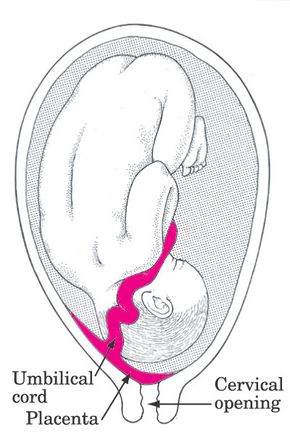Placenta previa is a condition in which the placenta is located low in the uterine cavity, partially or completely covering the opening of the cervix. This can cause bleeding and interfere with a normal vaginal delivery. It occurs in about 1 in every 200 pregnancies.
Although the cause of placenta previa is unknown, some experts believe that placental implantation cannot take place on the same part of the uterine wall more than once. If a woman has had several pregnancies, the lower part of the uterus may be the only place left on which the placenta can become implanted. That would explain why placenta previa is more common in women who have had previous pregnancies.
Advertisement
There are three types of placenta previa: complete, in which the cervix is completely covered; partial, in which only a portion of the cervix is covered; and low-lying or marginal, in which the placenta does not cover the cervix but is close enough to it to potentially interfere with delivery. A normal vaginal delivery cannot be attempted with any type of placenta previa because extreme hemorrhage will occur. For this reason, babies of most mothers with placenta previa are delivered by means of cesarian section.
The major symptom of placenta previa is painless vaginal bleeding. Bleeding may begin as early as the 24th to 26th week, though it is more common during the last 4 or 5 weeks. As the lower portion of the uterus stretches and dilates during the later weeks of pregnancy, portions of the placenta may be torn from their attachments to the wall of the uterus. This leads to bleeding in variable amounts, ranging from light to profuse.
The blood is usually bright red, indicating the bleeding is fresh. It is not associated with any previous injury, such as a fall. And abdominal pain or cramping does not usually accompany the bleeding unless the woman is in labor.
Since any vaginal bleeding during pregnancy is abnormal, it should be reported immediately to your physician. The doctor will order an ultrasound image of your abdomen to locate the placenta. In most cases of placenta previa, the ultrasound shows the placenta covering part or all of the opening of the cervix.
Once placenta previa has been diagnosed, the degree of vaginal bleeding usually dictates the type of treatment, either delayed or active. If vaginal bleeding is slight, delayed treatment is generally chosen because it allows the fetus time to mature enough to survive outside the mother's body. Delayed treatment involves admitting the woman to the hospital, keeping her on bedrest, and closely monitoring her for any recurrence of bleeding. When it is time to deliver the baby, a cesarian section will be performed.
If vaginal bleeding is heavy, it can lead to severe blood loss from the mother. The bleeding only stops after the baby has been delivered and the placenta has been removed. This requires active treatment to save the life of the mother and baby, even if the baby is premature. A cesarian section will be performed immediately if vaginal bleeding from placenta previa is heavy.
Advertisement


